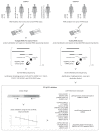mRNA Capture Sequencing and RT-qPCR for the Detection of Pathognomonic, Novel, and Secondary Fusion Transcripts in FFPE Tissue: A Sarcoma Showcase
- PMID: 36232302
- PMCID: PMC9569610
- DOI: 10.3390/ijms231911007
mRNA Capture Sequencing and RT-qPCR for the Detection of Pathognomonic, Novel, and Secondary Fusion Transcripts in FFPE Tissue: A Sarcoma Showcase
Abstract
We assess the performance of mRNA capture sequencing to identify fusion transcripts in FFPE tissue of different sarcoma types, followed by RT-qPCR confirmation. To validate our workflow, six positive control tumors with a specific chromosomal rearrangement were analyzed using the TruSight RNA Pan-Cancer Panel. Fusion transcript calling by FusionCatcher confirmed these aberrations and enabled the identification of both fusion gene partners and breakpoints. Next, whole-transcriptome TruSeq RNA Exome sequencing was applied to 17 fusion gene-negative alveolar rhabdomyosarcoma (ARMS) or undifferentiated round cell sarcoma (URCS) tumors, for whom fluorescence in situ hybridization (FISH) did not identify the classical pathognomonic rearrangements. For six patients, a pathognomonic fusion transcript was readily detected, i.e., PAX3-FOXO1 in two ARMS patients, and EWSR1-FLI1, EWSR1-ERG, or EWSR1-NFATC2 in four URCS patients. For the 11 remaining patients, 11 newly identified fusion transcripts were confirmed by RT-qPCR, including COPS3-TOM1L2, NCOA1-DTNB, WWTR1-LINC01986, PLAA-MOB3B, AP1B1-CHEK2, and BRD4-LEUTX fusion transcripts in ARMS patients. Additionally, recurrently detected secondary fusion transcripts in patients diagnosed with EWSR1-NFATC2-positive sarcoma were confirmed (COPS4-TBC1D9, PICALM-SYTL2, SMG6-VPS53, and UBE2F-ALS2). In conclusion, this study shows that mRNA capture sequencing enhances the detection rate of pathognomonic fusions and enables the identification of novel and secondary fusion transcripts in sarcomas.
Keywords: RT-qPCR; alveolar rhabdomyosarcoma; formalin-fixed paraffin-embedded (FFPE) tissue; fusion gene; fusion transcript; mRNA capture sequencing; sarcoma; undifferentiated round cell sarcoma.
Conflict of interest statement
C.F. is an employee, A.D.G., M.L. and S.S. are former employees, and J.V. (Jo Vandesompele) is co-founder and CSO at Biogazelle, a CRO providing RNA sequencing services. G.S. and S.K. are employees of Illumina, providing the TruSight RNA Pan-Cancer Panel. The other authors declare no potential conflict of interest. The sponsors had no role in the design, execution, interpretation, or writing of the study.
Figures

References
-
- Mitelman F., Johansson B., Mertens F. Mitelman Database of Chromosome Aberrations and Gene Fusions in Cancer. 2021. [(accessed on 11 September 2022)]. Available online: https://mitelmandatabase.isb-cgc.org.
-
- Qu X., Yeung C., Coleman I., Nelson P.S., Fang M. Comparison of four next generation sequencing platforms for fusion detection: Oncomine by ThermoFisher, AmpliSeq by illumina, FusionPlex by ArcherDX, and QIAseq by QIAGEN. Cancer Genet. 2020;243:11–18. doi: 10.1016/j.cancergen.2020.02.007. - DOI - PMC - PubMed
MeSH terms
Substances
LinkOut - more resources
Full Text Sources
Medical
Research Materials
Miscellaneous

